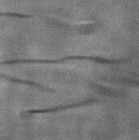 Swimmers with chiral morphology in shear flow
Swimmers with chiral morphology in shear flow
Swimming microorganisms often encounter shear flows. For example, bacteria moving in the turbulence of the ocean affect the efficiency of marine ecology and the carbon cycle. Shear flows are also produced near boundaries in the presence of background flow.  Thus, sperm traveling in the folds of the cervix and bacteria spreading infection in catheters encounter shear flows near walls. At the same time, many microorganisms have chiral body shapes or structures, like the helical flagella that propel bacteria such asE. coli. With Tom Powers (Brown), and Roman Stocker and Marcos (MIT), we have calculated that chiral bacteria in low-Reynolds-number shear flows undergo reorientation due to chirality, which results in a swimming response to flows, or bacterial rheotaxis. Using theory and experiment, we quantify bacterial rheotaxis, and explore how it can help or hinder processes such as chemotaxis.
Top right image caption: Bacteria with chiral, helical flagella encounter shear flows near boundaries. Second image caption: Shear flows generated in microchannels can produce chiral drift.
Thus, sperm traveling in the folds of the cervix and bacteria spreading infection in catheters encounter shear flows near walls. At the same time, many microorganisms have chiral body shapes or structures, like the helical flagella that propel bacteria such asE. coli. With Tom Powers (Brown), and Roman Stocker and Marcos (MIT), we have calculated that chiral bacteria in low-Reynolds-number shear flows undergo reorientation due to chirality, which results in a swimming response to flows, or bacterial rheotaxis. Using theory and experiment, we quantify bacterial rheotaxis, and explore how it can help or hinder processes such as chemotaxis.
Top right image caption: Bacteria with chiral, helical flagella encounter shear flows near boundaries. Second image caption: Shear flows generated in microchannels can produce chiral drift.
 Chirality dependent drift and chiral separation
Chirality dependent drift and chiral separation
With Tom Powers (Brown) and Roman Stocker and Marcos (MIT) we have also calculated that chiral objects in shear flow drift in a direction that depends on handedness. We have demonstrated that this drift can be appreciable in microfluidic channels using ~10 mm long, helical, spirochete bacteria. We propose that this phenomenon may be exploited to achieve chiral separation (stereoselection) of small particles (Published in Phys. Rev. Lett.[pdf]). For small particles, Brownian rotational diffusion destroys the chiral drift. Can we overcome this problem to achieve chiral separation in microfluidics down to the nanoscale? Additionally, most chiral particles are not helical. How does geometry affect chiral drift? [Funded by NSF CBET-0967510 and CBET-1067798]
Image caption: Spirochetes aligned with streamlines in channel.
 Swimmers with chiral morphology in shear flow
Swimmers with chiral morphology in shear flow  Thus, sperm traveling in the folds of the cervix and bacteria spreading infection in catheters encounter shear flows near walls. At the same time, many microorganisms have chiral body shapes or structures, like the helical flagella that propel bacteria such asE. coli. With Tom Powers (Brown), and Roman Stocker and Marcos (MIT), we have calculated that chiral bacteria in low-Reynolds-number shear flows undergo reorientation due to chirality, which results in a swimming response to flows, or bacterial rheotaxis. Using theory and experiment, we quantify bacterial rheotaxis, and explore how it can help or hinder processes such as chemotaxis.
Top right image caption: Bacteria with chiral, helical flagella encounter shear flows near boundaries. Second image caption: Shear flows generated in microchannels can produce chiral drift.
Thus, sperm traveling in the folds of the cervix and bacteria spreading infection in catheters encounter shear flows near walls. At the same time, many microorganisms have chiral body shapes or structures, like the helical flagella that propel bacteria such asE. coli. With Tom Powers (Brown), and Roman Stocker and Marcos (MIT), we have calculated that chiral bacteria in low-Reynolds-number shear flows undergo reorientation due to chirality, which results in a swimming response to flows, or bacterial rheotaxis. Using theory and experiment, we quantify bacterial rheotaxis, and explore how it can help or hinder processes such as chemotaxis.
Top right image caption: Bacteria with chiral, helical flagella encounter shear flows near boundaries. Second image caption: Shear flows generated in microchannels can produce chiral drift.


 Chirality dependent drift and chiral separation
Chirality dependent drift and chiral separation